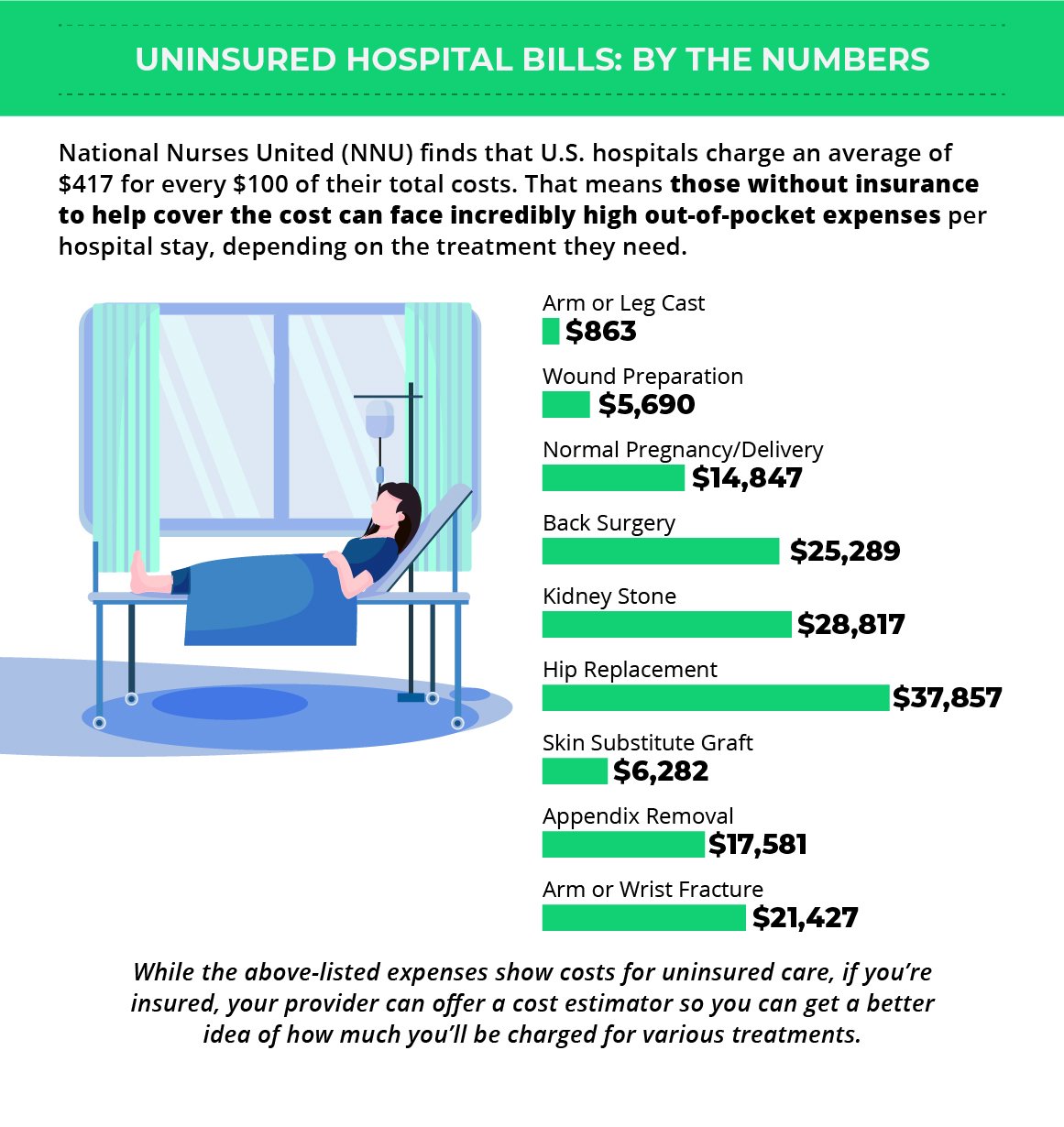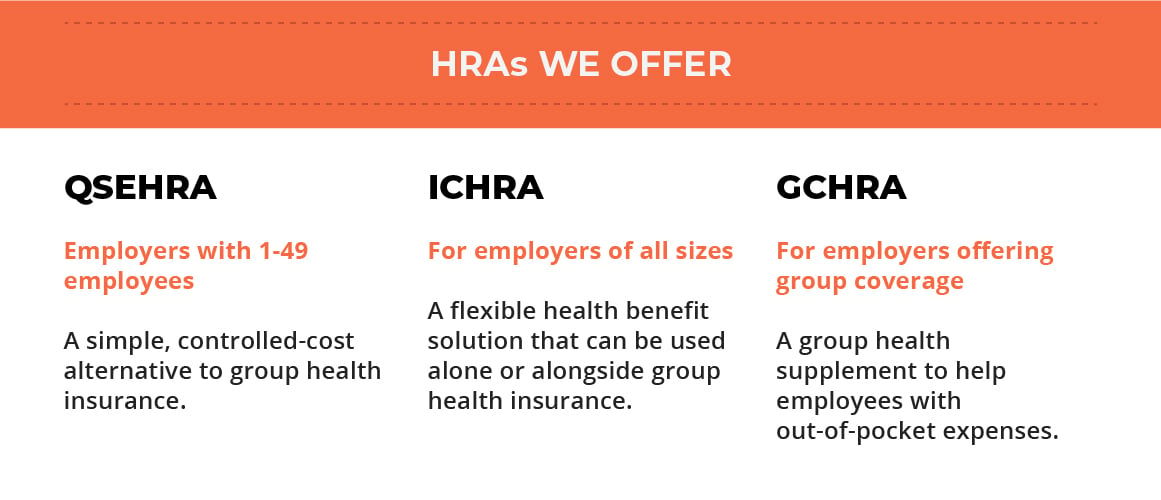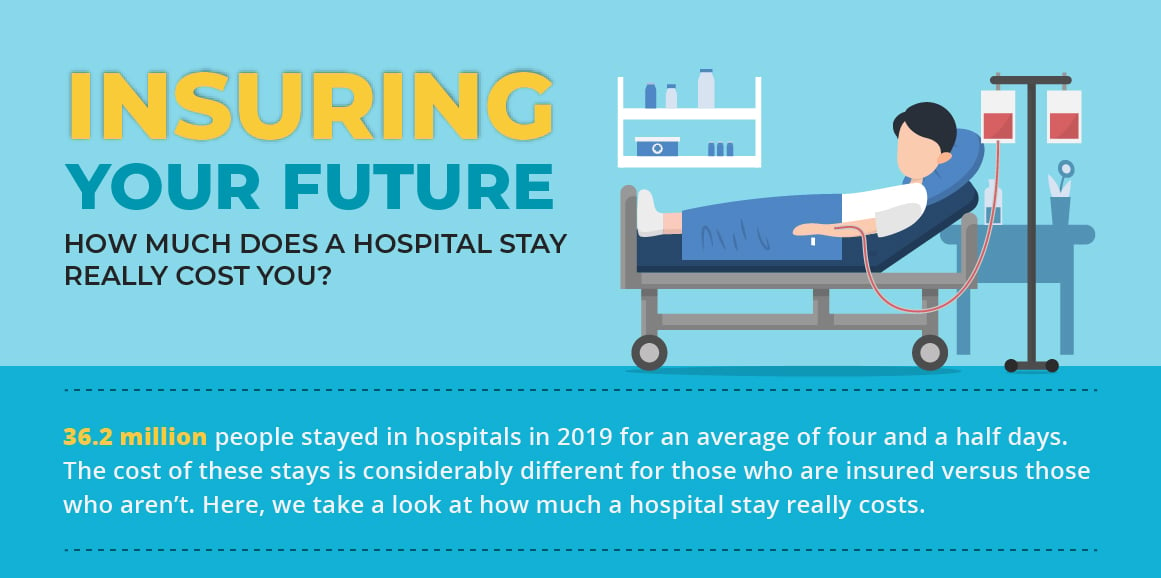Infographic: How much does a hospital stay cost?
Health Benefits • January 18, 2024 at 8:00 AM • Written by: Holly Bengfort
For many people, medical emergencies are concerning not only because of the potential health issues but also the financial burden they may bring. From doctor visits and minor injuries to emergency care and major medical issues, health insurance can protect us financially when we're sick or injured. However, the cost of a major medical care expense like a hospital stay is often unknown until the final bill arrives in the mail.
In this article, we'll share the average hospital stay cost by type of insurance, including the costs for those without medical coverage. We'll also break down the cost of various medical procedures.
Takeaways from this blog post:
- Hospital stays can incur significant costs, including those from medical procedures, room charges, medications, doctor fees, and additional services.
- There were more than 34 million hospital admissions in the United States in 2021.
- The average cost of an overnight hospital stay was $2,883 in 2021.
What does a hospital stay consist of?
It's important to be prepared and informed about the potential financial burden that a hospital stay can bring. Here's a breakdown of some of the costs you may encounter during a hospital stay in the United States.
1. Medical procedures and treatments
The cost of medical procedures and treatments can vary widely based on the complexity and length of the stay. For example, a routine surgery can range from a few thousand dollars to tens of thousands of dollars. Costs can increase further if there are complications or additional procedures required.
2. Room charges
Hospital room charges are a significant part of the overall cost. The type of room you choose, such as a private room or shared room, can significantly impact the amount you pay. Private rooms are more expensive, and rates vary depending on the hospital and location.
3. Medications
Medication costs during a hospital stay can add up quickly. Depending on the drugs prescribed, the cost can skyrocket. Expensive specialty medications can significantly increase the overall bill. It's essential to inquire about generic alternatives or explore other cost-saving options.
4. Doctor and specialist fees
In addition to the hospital charges, you'll also have to pay for the services provided by doctors, surgeons, anesthesiologists, and other specialists involved in your care. These fees can vary, especially if you require specialized care or consultations.
5. Additional services and facilities
There can be additional charges for various services and facilities, including laboratory tests, diagnostic imaging, ambulance services, physical therapy, and more. Each of these services has its own associated costs, which can quickly add up during a hospital stay.
How many people stay in hospitals each year?
Now that we’ve explained which services a hospital can charge you for, let's examine how many patients stay in hospitals each year. According to the 2023 American Hospital Association's Fast Facts on U.S. Hospitals1, there were 6,129 hospitals in the United States. Of these hospitals, 84% are community hospitals.
According to the AHA, community hospitals are generally smaller and serve their local communities. It doesn’t consider federally-run institutions or teaching hospitals as community hospitals.
According to the 2023 report, which analyzes data from the 2021 AHA Annual Survey, there were 34,011,386 hospital admissions. This includes inpatient admission and other medical services at community hospitals, rural hospitals, and hospital systems. This is up from the 33 million admissions analyzed for the 2020 survey.
The Agency for Healthcare Research and Quality2 (AHRQ), which is part of the U.S. Department of Health and Human Services, analyzed the most common diagnoses (though not necessarily the most expensive conditions) for inpatient hospital admission in 2020—other than maternal and neonatal stays. We've provided this information in the table below, along with the average price of hospital stays. The data between 2018 and 2020 shows the number of hospital stays decreased for most diagnoses. KFF3 attributes this to the rise of COVID-19 in 2020, leading to fewer people seeking medical care for non-COVID-related services.
|
Inpatient admission diagnoses |
Number of hospital stays in 2018 |
Number of hospital stays in 2020 |
Average cost of hospital stay |
|
Septicemia |
2,218,800 |
2,396,400 |
$18,2443 |
|
COVID-19 |
N/A |
1,058,815 |
$11,2754 |
|
Heart failure |
1,135,900 |
1,003,270 |
$13,4185 |
|
Diabetes mellitus (with complications) |
678,600 |
659,950 |
$8,4396 |
|
Osteoarthritis |
1,128,100 |
606,741 |
$16,0007 |
| Acute myocardial infarction |
658,600 |
570,440 |
$18,9318 |
|
Pneumonia (except those caused by tuberculosis) |
740,700 |
560,450 |
$6,0429 |
|
Cardiac dysrhythmias |
620,000 |
526,635 |
$12,100 |
|
Cerebral infarction |
533,400 |
515,400 |
$14,900 |
|
Acute and unspecified renal failure |
565,800 |
470,635 |
$9,600 |
How much does an average overnight hospital stay cost?
KFF4 found that the average per-day hospital cost was $2,883 in 2021. But, this price tag varies significantly by the type of insurance coverage you have and if you have insurance coverage at all. The exact cost also differs depending on where you live.
Let's review some of the average costs you can expect to pay in different states.
|
State |
Average per-day hospital cost |
|
New York |
$3,609 |
|
Rhode Island |
$3,010 |
|
South Carolina |
$2,511 |
|
South Dakota |
$1,632 |
According to HealthCare.gov5, the average price of a three-day hospital stay is approximately $30,000.
.jpg?width=693&name=Healthcare%20Infographic_2%20(1).jpg)
How much are healthcare costs increasing?
According to KFF, the average hospital stay cost increased by 161.7% between 1999 and 2021.
How insurance helps lower hospital costs
While the data show that uninsured patients have a lower average hospital stay cost, it's important to remember that private insurance companies often set an out-of-pocket maximum. While your bill may be high, you'll only have to pay the amount your provider has set as our maximum out-of-pocket cost.
In addition, most insurance companies will often negotiate your hospital costs, helping you get a discounted price compared to what the hospital initially charged you.
Here’s a look at what you might pay for each hospital bill without insurance:

According to National Nurses United6 (NNU) in 2020, U.S. hospitals charged uninsured patients an average of $417 for every $100 of their total costs. This means those without insurance to help cover the cost can face high out-of-pocket expenses during their hospital stay.
Even with health insurance coverage, hospitalization costs can be staggering. Sometimes, patients who received treatment at an out-of-network hospital for their insurance company would get surprise medical bills. These surprise bills incurred additional medical care costs for patients. In 2022, the No Surprises Act took effect, helping to eliminate or reduce many surprise bills across the country.
Estimating your hospital bill costs
Whether or not you have insurance isn't the only factor influencing your hospital bill.
Let’s look at a few common factors that can affect how much you pay out-of-pocket:
- Where you live: Your state, ZIP code, cost of living, and availability of doctors and insurers in your area all affect your cost.
- What insurance you have: Your insurance company will often negotiate lower prices for you, so uninsured patients are left to negotiate on their own.
- Which network you’re in: Make sure your doctor and hospital are in your network. In some cases, you won’t get the same negotiated discounts or be able to apply the cost toward your deductible if you’re out of network.
- Who your provider is: Specialists have a unique skill set, so they generally charge more than a primary care facility.
- Where you go: Different facilities charge more or less. Hospitals are more expensive than ambulatory surgical centers, while urgent care and physician’s offices are less costly.
- How you negotiate: If you can’t pay the full price of your hospital bill, you may be able to negotiate a lower price that’s more affordable.
How employers can help their employees cover their medical bills
With the costs of hospital visits and overnight stays rising, it can be daunting to think about the price you'll pay if you're ever sick, in an accident, or if any medical conditions arise. In the U.S., most medical insurance is tied to employment.
Small employers and nonprofits face challenges when providing health benefits to their employees. This is especially true with the rising cost of traditional employer plans. That's where alternative employer-provided health benefits such as health reimbursement arrangements (HRAs) can come in handy.
HRAs
If you're an employer, an HRA allows you to reimburse your employees for their individual health insurance premiums and qualifying medical expenses with tax-free money. This includes monthly premiums, medical bills, and out-of-pocket costs. Depending on the type of HRA you offer, your employees can choose their own health insurance plans. This allows them to choose the right coverage for their unique needs.
If an employee has a medical bill from their hospital stay that qualifies for reimbursement, an HRA allows you to reimburse them up to their monthly allowance.

If you run a small business or nonprofit with fewer than 50 full-time equivalent employees (FTEs), a qualified small employer HRA (QSEHRA) might work best for you. While the IRS caps annual allowances, they're an affordable alternative to traditional group health insurance and can help your employees pay for insurance that covers the cost of hospital stays.
An individual coverage HRA (ICHRA) is an excellent option for organizations of all sizes that want more flexibility with their benefit, including the ability to create employee classes.
HRAs aren't only available for those with individual health insurance coverage. You can also use them for supplemental health coverage. If you already offer a group health insurance plan, such as a high deductible health plan (HDHP), you can use a group coverage HRA (GCHRA) to supplement your policy. This ancillary benefit is also known as an integrated HRA.
How to get financial assistance
Whether you're an uninsured patient or just facing a hefty medical bill, explore your options for financial aid programs or payment plans.
The federal government requires many hospitals, medical centers, and health systems to provide financial assistance to patients who can't afford medical bills for services that are deemed "medically necessary." This includes inpatient hospital stays and emergency room visits.
According to the Affordable Care Act (ACA), nonprofit hospitals must have written policies outlining eligibility criteria for financial assistance and specifying whether that assistance covers free or discounted healthcare. It's worth contacting your hospital's medical billing or financial aid department to discuss your options.
Conclusion
Hospital stays in the United States can be expensive. It's important to be aware of the potential costs so you can make informed decisions regarding your healthcare. Understanding the breakdown of expenses and exploring options for financial assistance can help alleviate the burden and ensure you are prepared for the financial impact of a hospital stay.
With personalized health benefits such as HRAs, an employer can help you better afford your medical expenses, including costs associated with hospitalization. If you're an employer looking to provide your employees with a health benefit, PeopleKeep can help. Our HRA administration software helps organizations like yours to easily set up their benefit in minutes.
The information in this article isn't financial or medical advice. You should consult with the relevant professionals for specific advice related to your situation.
This blog article was originally published on November 21, 2013. It was last updated on January 18, 2024.
- https://www.aha.org/statistics/fast-facts-us-hospitals
- https://datatools.ahrq.gov/hcup-fast-stats/?tab=national-hospital-utilization-costs&dash=75
- https://www.kff.org/report-section/how-were-hospital-admissions-impacted-by-covid-19-trends-in-overall-and-non-covid-19-hospital-admissions-through-august-8-2020-issue-brief/
- https://www.kff.org/health-costs/state-indicator/expenses-per-inpatient-day/?currentTimeframe=0&sortModel=%7B%22colId%22:%22Location%22,%22sort%22:%22asc%22%7D
- https://www.healthcare.gov/young-adults/ready-to-apply/
- https://www.nationalnursesunited.org/sites/default/files/nnu/graphics/documents/1120_CostChargeRatios_Report_FINAL_PP.pdf
- https://www.ncbi.nlm.nih.gov/pmc/articles/PMC6250243/
- https://www.cidrap.umn.edu/cost-hospital-care-rose-26-covid-19-patients-over-course-pandemic-data-show
- https://www.ajmc.com/view/heart-failure-population-health-considerations
- https://www.ncbi.nlm.nih.gov/pmc/articles/PMC10390920/#:~:text=The%20median%20costs%20per%20diabetes,total%20monthly%20diabetes%2Drelated%20costs.
- https://hcup-us.ahrq.gov/reports/statbriefs/sb277-Top-Reasons-Hospital-Stays-2018.jsp
- https://pubmed.ncbi.nlm.nih.gov/30975005/
- https://pubmed.ncbi.nlm.nih.gov/9737840/#:~:text=The%20average%20hospital%20length%20of,bill%20for%20patients%20with%20CAP.
Subscribe now for insider access to our latest content!
Holly Bengfort
Holly Bengfort is a content marketing specialist at PeopleKeep, with two years of experience in HRAs and health benefits. Having experienced the QSEHRA firsthand as an employee, Holly provides invaluable insights into how it can benefit small businesses and their workforce. Before joining the team in 2023, Holly worked in television news as a broadcast journalist. With her experience as a news anchor and reporter, Holly has an exceptional ability to break down intricate stories into clear, compelling narratives that resonate with diverse audiences. Her talent for simplifying tricky topics ensures that everyone can fully grasp important information. Outside of work, Holly enjoys spending time outdoors, staying active, and relaxing on the beach.

